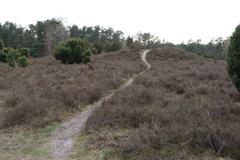Krelinger Heide Visiting Hours, Tickets, and Historical Sites in Walsrode
Date: 01/08/2024
Introduction
Krelinger Heide, located on the southern edge of Krelingen in Walsrode, Germany, is a small yet picturesque heathland area that offers visitors a unique blend of natural beauty, historical significance, and cultural heritage. This guide provides a comprehensive overview of Krelinger Heide, covering its historical background, cultural importance, practical visitor information, and nearby attractions. Whether you’re a history buff, nature enthusiast, or simply seeking a peaceful retreat, Krelinger Heide has something to offer. The heathland is part of the larger Lüneburg Heath, a region shaped by centuries of human activity, including grazing and controlled burning, which have preserved its open landscape and prevented forest encroachment (wanderklaus.de). A key historical landmark is the Großsteingrab Krelingen, a megalithic tomb dating back approximately 4,000 years, offering valuable insights into the burial practices and social structures of prehistoric communities. Furthermore, the heathland’s cultural significance is enhanced by traditional practices such as grazing by moorland sheep, known locally as Schnucken, which play a crucial role in maintaining the heath’s ecological balance (lueneburger-heide.de).
Table of Contents
- Introduction
- Historical Background
- Cultural Significance
- Visitor Information
- Travel Tips
- Nearby Attractions
- Special Events and Guided Tours
- Photographic Spots
- FAQ
- Conclusion
Historical Background
Krelinger Heide’s history is deeply intertwined with the broader historical context of the Lüneburg Heath, a significant cultural and natural landscape in Lower Saxony. The heathlands have been shaped by human activity over centuries, particularly through grazing and controlled burning, which have maintained the open landscape and prevented forest encroachment.
The Krelinger Heide is notable for its historical landmarks, including ancient burial sites. One of the most significant historical features is the Großsteingrab Krelingen, a megalithic tomb dating back approximately 4,000 years. This ancient grave is a testament to early human settlements in the area and provides valuable insights into the burial practices and social structures of prehistoric communities (wanderklaus.de).
Cultural Significance
The cultural significance of Krelinger Heide extends beyond its historical landmarks. The heathland is a living cultural landscape, maintained through traditional practices such as grazing by moorland sheep, known locally as Schnucken. These sheep play a crucial role in preserving the heath by grazing on grasses and shrubs, which prevents the area from becoming overgrown and ensures the survival of heather plants (lueneburger-heide.de).
Visitor Information
- Visiting Hours: Krelinger Heide is open year-round, but the best times to visit are during the blooming season of the heather, typically from late July to early September.
- Tickets: Entry to Krelinger Heide is free. However, guided tours may have associated costs.
- Accessibility: The area is accessible to visitors of all ages. Some paths may be challenging for those with mobility issues, so it’s advisable to check the specific routes ahead of time.
Travel Tips
- Attire: Wear comfortable walking shoes and weather-appropriate clothing.
- Essentials: Bring water, snacks, and a camera to capture the scenic views.
- Respect Nature: Stay on marked paths to protect the delicate heathland ecosystem.
Nearby Attractions
- Walsrode Bird Park: One of the largest bird parks in the world, offering a diverse array of avian species and beautiful gardens.
- Serengeti Park: A safari park featuring a wide range of animals and family-friendly activities.
- Heide Museum: Learn more about the cultural and natural history of the Lüneburg Heath region.
Special Events and Guided Tours
- Heath Bloom Festival: Celebrate the blooming of the heather with local festivities and cultural events.
- Guided Tours: Available through local tourism offices, offering in-depth insights into the history and ecology of the region.
Photographic Spots
- Megalithic Tomb: Capture the ancient Großsteingrab Krelingen.
- Heather Fields: The fields in full bloom provide a stunning backdrop for photography.
- Sunrise and Sunset: The lighting during these times offers beautiful, soft hues for capturing the landscape.
FAQ
- Is there an entrance fee for Krelinger Heide? No, entry is free.
- When is the best time to visit? Late July to early September during the heather blooming season.
- Are there guided tours available? Yes, guided tours are available through local tourism offices.
- Can I bring my dog? Yes, dogs are allowed but must be kept on a leash.
Conclusion
Krelinger Heide is a destination rich in history and cultural significance, offering visitors a unique glimpse into the past and the beauty of the heathland. Whether you’re a history enthusiast, nature lover, or just looking for a peaceful retreat, Krelinger Heide has something to offer. Be sure to check out other related posts and follow us on social media for the latest updates and tips (Travellers Worldwide).
References
- Wanderklaus. (2020). Krelinger Rundwanderung. wanderklaus.de
- Lüneburger Heide. (n.d.). Krelinger Heath. lueneburger-heide.de
- Travellers Worldwide. (n.d.). Best Time to Visit Germany. travellersworldwide.com

